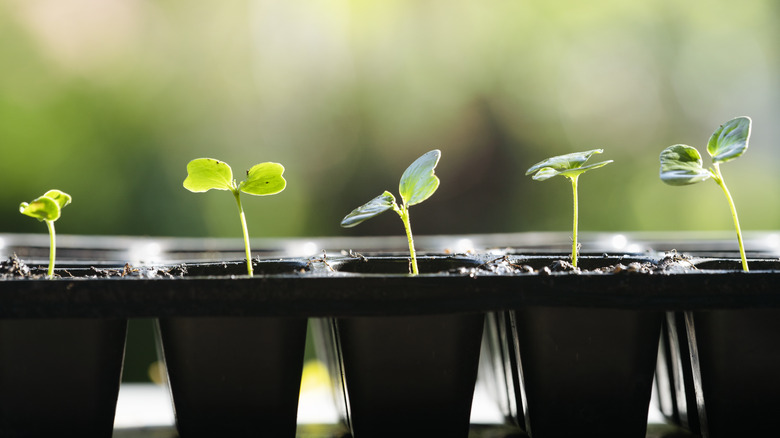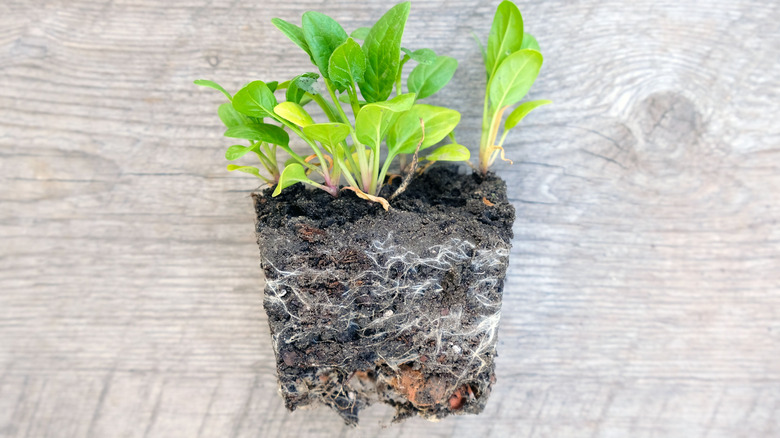Why TikTok Recommends To Avoid Starting Seeds In Plastic Trays
As rewarding as growing your own garden from seed is, it can also be surprisingly stressful, and problems with seed starting can impact your entire growing season. One of the first things to consider when starting seeds is what type of containers you'll use. While plastic plug trays have long been a popular option, many users on TikTok recommend against them, both for environmental reasons and out of concern for your seedlings' health. Luckily, there are many great seed-starting alternatives available for anyone who wants to get away from using plastic plug trays.
There's a lot to consider when starting your own seeds indoors. In addition to deciding what types of containers to use, you also need to ensure your seedlings have the necessary light, warmth, and humidity to thrive. You should also look into how early to start different seeds so they're the perfect size when you're ready to transplant them. While some seeds, like peppers, should be started at least two months before your last frost, others should be started only a few weeks before transplanting. Don't feel that you need to, or even should, start all your seeds indoors. While some seeds benefit from starting indoors, others, like melons, beans, and cucumbers, grow best with direct sowing.
Disadvantages of plastic seed starting trays
As popular as plastic plug trays are for seed starting, they also come with some major downsides. One of the biggest issues with plastic plug trays is how easily seedlings can become root-bound. A plant becomes root-bound when its roots run out of growing space in its container and begin growing in circles. Depending on how tangled the roots are, this can cause the seedling to die. Even after being transplanted outside, root-bound seedlings may continue to struggle and might not acclimate to their new location as quickly as seedlings with healthy roots.
Plastic trays also carry sustainability issues, as some are not terribly durable and can wear out after only a few uses, sending more plastic to landfills. Buying higher-quality plastic seed starting containers can somewhat mitigate this issue, but you still need to spend time and energy washing and sanitizing all the small crevices of the plug trays after each use to prevent fungal diseases and other pathogens from infecting your seedlings. But if you're set on using plastic containers, Iowa State University Extension recommends first washing the containers with soapy water and then soaking them in a mix of 1 part bleach to 9 parts water for at least 10 minutes.
Alternatives to plastic seed trays
Luckily, giving up on plastic plug trays doesn't have to mean giving up on seed-starting, as there are multiple other options available to you. One of the most popular sustainable seed-starting alternatives is soil blocking, where instead of putting seed-starting mix into multiple small sections of a tray, the growing medium is instead compacted into a square using a soil block press. These tightly packed blocks can be placed in a wood frame or a plastic tray. With this method, seedlings are far less likely to become root-bound: Once they reach the edge of the soil block, the roots are naturally air-pruned instead of wrapping around. This results in stronger and healthier seedlings that transplant more easily. It is important to use a growing medium specifically designed for soil blocking if you opt to try this method.
Homemade newspaper pots are another popular seed-starting option. Once the pots are constructed, you fill them with seed starting mix and plant your seeds. While newspaper pots can get a bit messy once the newspaper begins to break down, trials of newspaper pots for seed-starting found that this method resulted in happy seedlings with healthy roots.

